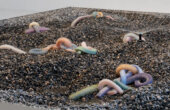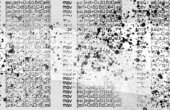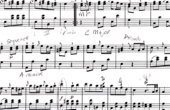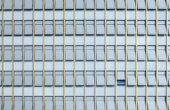The Women Who Refused to Choose Between Mothering and Artmaking
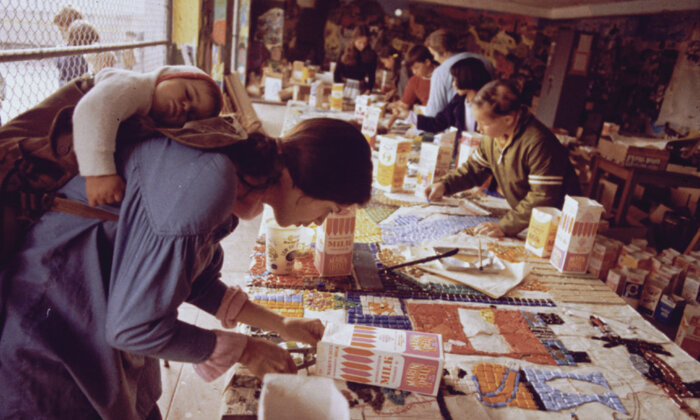
In midcentury America, portraying an artist’s identity as not simply coincident with motherhood but dependent upon it was utterly unheard of. The image of the solitary male artist dominated public perception, and while many women who made art also had children, few dared link the two identities. As feminist critic Lucy Lippard wrote in 1973, looking back on these decades, “the few women artists making it in the 1950s and 1960s were rarely housewives, and anybody who was took care to hide it when showing her work in the serious art world. (Because women were considered ‘part-time artists’ if they worked for a living outside of art, or were married, or had a child, they didn’t have to be taken seriously.)”
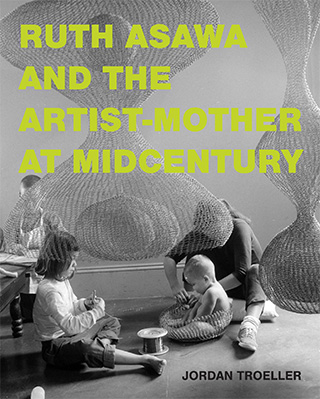
Every woman knew that the consequences of collapsing these two personas — mother and artist — were severe, resulting in ostracism and invisibility. To borrow from the Bay Area writer Ursula K. Le Guin, this “received wisdom” stipulated “that any attempt to combine art work with housework and family responsibilities is impossible, unnatural.”
Yet in midcentury San Francisco, a small group of women quietly resisted that narrative. Artists including Ruth Asawa, Merry Renk, Nancy Thompson, and Imogen Cunningham challenged the supposed incompatibility of creativity and caregiving. They didn’t just make art while raising children; they made motherhood central to their creative lives.
Even more than shared circumstances and geographical proximity, what holds these women together is their rejection — each in her own way — of what painter Alice Neel called the “awful dichotomy”: the belief that artmaking and caretaking are at odds with one another, as two opposing and irreconcilable terms. We see this dichotomy invoked repeatedly in accounts of midcentury women artists, especially painters; it is often the mechanism through which art historical discourse judges a woman artist’s legitimacy.
Every woman knew that the consequences of collapsing these two personas — mother and artist — were severe, resulting in ostracism and invisibility.
Take, for instance, this recent account of Grace Hartigan, who in April 1951, the author relays, “had long before concluded that she could not be both a serious artist and a mother and had given [her son] Jeff to his grandparents to be raised in New Jersey. Now she saw her son only during emotionally charged weekends. The rest of her time was spent painting, or struggling to find the money to buy the materials to paint. The relationships she valued most were those that enabled or inspired her — with painters or poets, or lovers who were content to remain as such. Anything else (especially that cumbersome attachment called a husband) was a distraction she could not afford and would not tolerate.” The message here is clear: Children amount to “distractions” from the serious business of artmaking, and those relationships that matter “most” had nothing to do with family, friendships, or neighbors. Anyone — or rather, any woman — wholly committed to her art had to make the difficult but necessary choice.
If this sounds old-fashioned, keep in mind that this passage was taken from the pages of a recent New York Times bestseller. It is powerful stuff, this mythology that the work of making art is so engrossing, so monumental in scope and feeling, that it would even drive a mother to abandon her son. It persists even in those accounts that attempt to be on the right side of history, telling the stories of women who had long been marginalized from the record. But even in the 1950s, it was not true that children were intolerable for the artist-mother — what was intolerable was motherhood itself from the perspective of an art world that compelled women to make a difficult choice.
And just when we think this mythologizing is confined to the mass market, consider a recent scholarly book on Helen Frankenthaler, which frames the topic of motherhood as a litany of suicides, depression, dead infants, and miscarriages, all of which, we are told, Frankenthaler blithely rejected. To describe such claims as pervasive is an understatement; they voice an institution deeply internalized in our conceptions of midcentury art history. We find it even reinforced by some of these women themselves, as in the case of Emily Mason when she told the painter Janice Biala that she was two months pregnant, to which Biala responded, “Oh good. There is still time for an abortion.” Or Louise Bourgeois, who describes a watercolor that she made in the early 1940s as portraying herself as a mother “stuffing my face with [the child] . . . Medea killed her children as an act of revenge. I want to abolish them because they are a fact, because they are such a huge burden.” The “burden” here, though, is not the fact of having a child, but the punishment imposed for wanting to be an artist at the same time.
The notion that “creation and femininity are incompatible,” to borrow from Anaïs Nin, is not exclusive to the decades that my book on Ruth Asawa addresses, but it is one of the period’s overriding attributes: It is “the agony — particularly mid-century, escaped by their sisters of pre-Freudian, pre-Jungian times,” as Tillie Olsen writes. Which is to say that although this dichotomy tends to be cast as universal, it is historically specific, and relies on a theory of culture that gains traction in the wake of Freud. That theory of culture casts all artistic production as originating in the repression of erotic life, in a rejection of the Mother.
Without going into the technical language of this theory, one can grasp its message in the words of sculptor Reg Butler, addressing a group of art students in 1962: “I am quite sure that the vitality of many female students derives from frustrated maternity, and most of these, on finding the opportunity to settle down and produce children, will no longer experience the passionate discontent sufficient to drive them constantly towards the labors of creation in other ways. Can a woman become a vital creative artist without ceasing to be a woman except for the purposes of a census?” According to this script, the “vitality” of the artwork emerges only in the absence of vitality in its most literal form — as the generation of new life. When one is invoked, the other becomes superfluous. Literary scholar Susan Rubin Suleiman spells out how this tenet shifted from a moral obligation to “a psychological ‘law’” for psychoanalysts like Helene Deutsch, who equated “the creative impulse with the procreative one and decree[d] that she who has a child feels no need to write books.” It is, as Suleiman suggests, what we might call “the menopausal theory of artistic creation.”
What is significant here is that statements like Reg Butler’s cannot be explained away through misogyny alone. We are speaking here of a much more systematic problem, one that had less to do with gender bias than it did with a foundational paradigm of artistic making based on a Freudian model of subjectivity. One criterion of that paradigm was that art must stand in a relation of difference to life, to embody that vitality but also distinguish itself from it. Woman had to be, to quote two art historians, “the antithesis of cultural creativity,” because she was the epitome of biological creativity. It is a narrative that bolstered the Romantic notion of the artist as tortured genius, which in turn informed the Freudian paradigm. As Sarah Kofman summarizes it: “Society takes the artist to be the father of his creation, and the artist, wishing to believe himself the father of his works, wants to be his own father. Society therefore grants full license to the artist to show that he is subject to no external constraints, that he is free and fully his own master, that like God, he is self-sufficient.” Fathers, even as women, make art, but Mothers cannot.
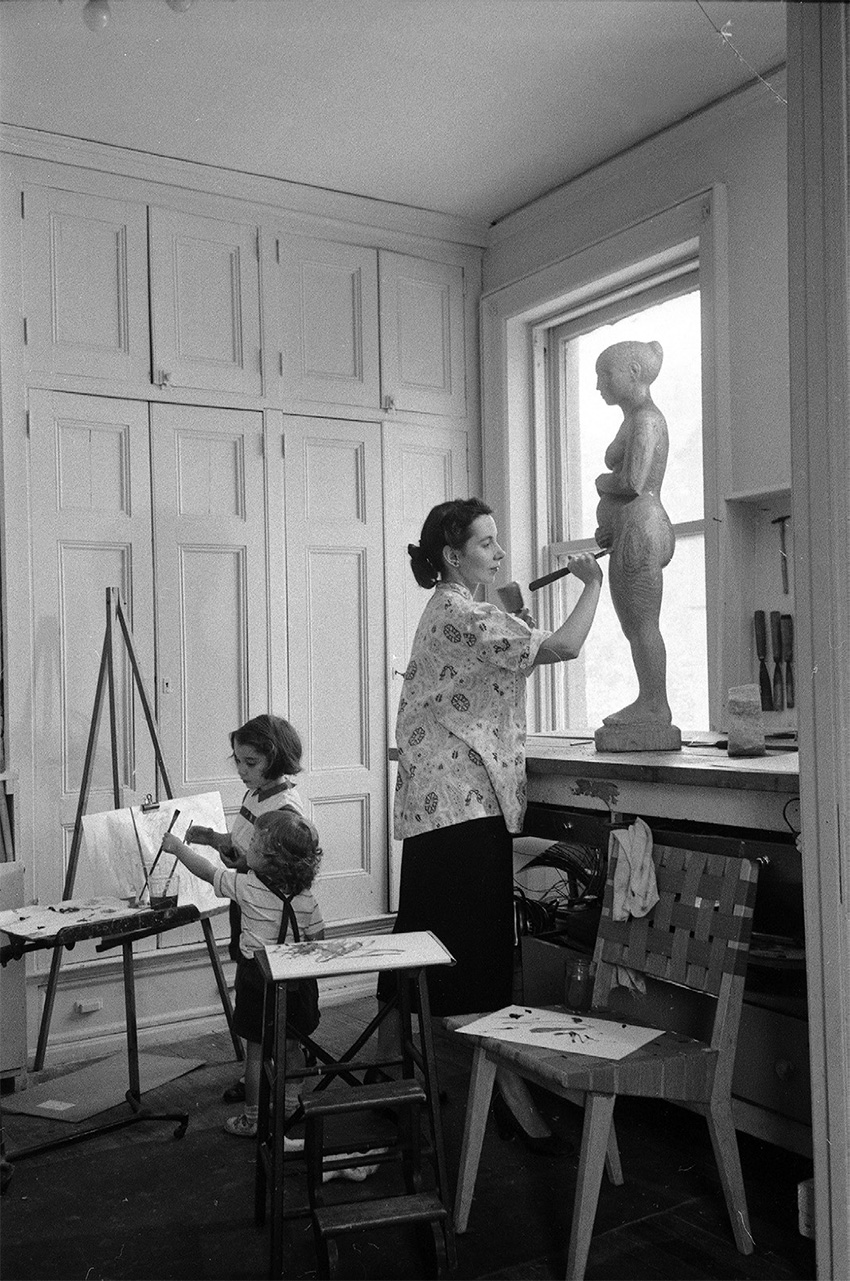
One coordinate in sketching out the relationship of art to motherhood at midcentury is a 1954 Life magazine feature on the sculptor Isabel Case Borgatta. Here the situation is reversed: The artist’s work is not opposed to her identity as mother but rather reduced to it. Photographs by Andreas Feininger depict the artist at work in her studio: Borgatta carving her wooden figure is mirrored in her daughters’ dabbing at an easel nearby, as if mother is merely playing at making art. The Life feature not only collapses Child and Woman, it subtly invokes metaphors of artmaking which analogize it to pregnancy and birth, metaphors that historically have been invoked by men. These are metaphors in which the action of artistic production is spoken of as if it were the action of mothering: Tillie Olsen points us to the example of Balzac’s self-professed “unwearying maternal love, this habit of creation.” Life magazine casts Borgatta’s pregnancy in the terms of this metaphorized maternity. Her rounded belly faces the pregnant statue in a kind of maternal revision of the Pygmalion myth, in which the male artist falls in love with his creation and thus brings her to life. “Now about to produce her third child,” readers are told, “she has succeeded in completing her latest sculpture [“Expectation”] in just nine months.”
Behind the two expecting mothers, one animate and the other inanimate, two children play. True to the article’s subtitle — “Wife Coordinates Her Statues with Her Babies” — Life went to some length to make certain for the reader that, whatever kind of artmaking this was, it was compatible with the duties of motherhood; there would be no possibility of neglect here. A carved alabaster child, the caption states, “was [a] subject suggested to Mrs. Borgatta by her 4-year-old daughter,” while the figure of a mother and child “was made to express the intense protective love that [the] sculptor felt toward her own new baby”; and, finally, First Born “was actually made after [the] second Borgatta baby arrived,” and it will serve as a “model for a large work which the sculptor will make after her next child is born.” No need for further explanation; motherhood encompasses art’s subject, meaning, choice of title, and even deadline.
An elucidation of the mythology underlying the Borgatta feature is furnished by Roland Barthes in his essay “Novels and Children,” which appeared in 1957. This is the same year that Imogen Cunningham took powerful photographs of Asawa working at home around her children, which I discuss at length in my book. Here the myth at issue is the inversion of Neel’s awful dichotomy: it is only because the artist is a mother that her work is allowed to qualify as art. Let me explain. Barthes’s topic is an issue of Elle magazine that profiles some 70 women writers. Each photograph, he tells us, is accompanied by captions such as these: “Jacqueline Lenoir (two daughters, one novel)”; “Marina Grey (one son, one novel)”; “Nicole Dutreil (two sons, four novels)” — the list goes on. This is the woman writer’s “double parturition,” he proposes; “children and novels alike seem to come by themselves, and to belong to the mother alone.” What does it all mean, he asks?
This:
Women are on the earth to give children to men; let them write as much as they like, let them decorate their condition, but above all, let them not depart from it: let their Biblical fate not be disturbed by the promotion which is conceded to them, and let them pay immediately, by the tribute of their motherhood, for this bohemianism which has a natural link with a writer’s life.
Women, be therefore courageous, free; play at being men, write like them; but never get far from them; live under their gaze, compensate for your books by your children; enjoy a free rein for a while, but quickly come back to your condition.
Determining and limiting this condition is the absent male figure, “nowhere and everywhere.” It is his presence that undergirds the litany of children and novels, “the miraculous products of an ideal parthenogenesis able to give at once to women, apparently, the Balzacian joys of creation and the tender joys of motherhood.” This is the other side of the dichotomy: Instead of disallowing a woman’s ability to create, motherhood guarantees it. Allow women “the Balzacian joys of creation,” but let their work always be determined by “their Biblical fate.” In this way, the creative power of the female sex is contained and controlled. Both Elle and Life stage “a Molièresque scene, say[ing] yes on one side and no on the other,” and thus “displeasing no one.” This is so powerful a myth in Western culture that its components can be reversed and still hold true. To cite the poet Alicia Ostriker: “That women should have babies rather than books is the considered opinion of Western civilization. That women should have books rather than babies is a variation on that theme.”
Jordan Troeller is Junior Professor of Contemporary Art and Aesthetic Practices at Leuphana Universität Lüneburg, where she leads the research group The M/Other Project: Creativity, Procreation, and Contemporary Art, funded by the VolkswagenStiftung. She is the author of “Ruth Asawa and the Artist-Mother at Midcentury,” from which this article is adapted.
